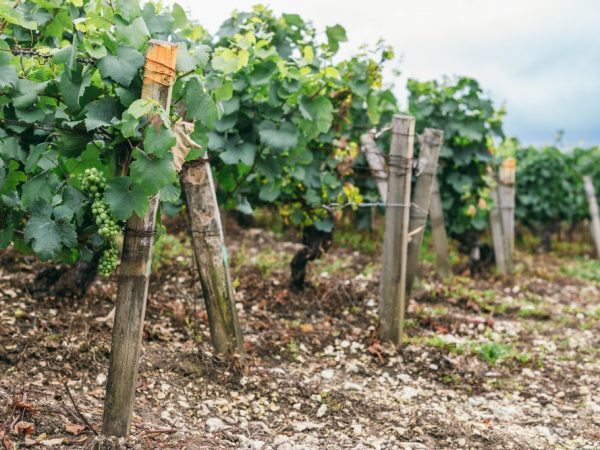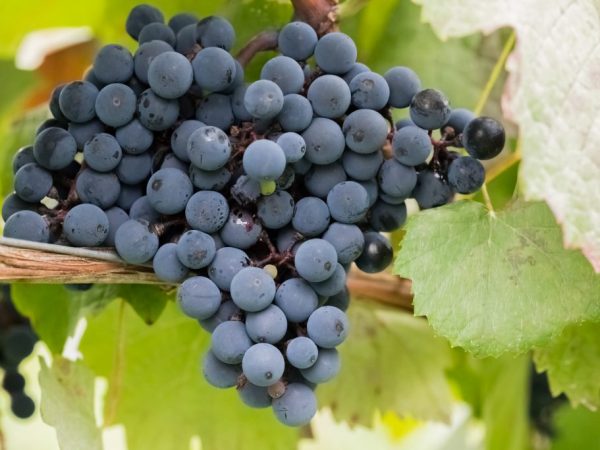Description of the grape variety Augusta
One of the most important characteristics of grapes is resistance to temperature extremes, diseases and pest attacks. For this, breeders bred the Augusta grapes. It is not too expensive to grow and has good taste and technological qualities.

Description of the grape variety Augusta
Characteristic
The Augusta grape is a technical variety. It ripens early. In the southern regions, the harvest begins at the end of August. The production period takes 130 days.
This is a variety with an average yield of 150 kg / ha. To get a good harvest, it is important to properly care for your plants.
Description of the bush
The Augusta grape bushes stand out for their intense growth. Leaves are dense, round, reticulate-wrinkled, have dome-shaped denticles.
There is an open petiole notch, petioles are red-brown in color. The vine is small.
Description of fruits
The berries of this variety are small, average weight - 1.4 g. Round shape, deep dark blue color. The weight of the bunch is 100-120 g.
Juicy pulp, juice does not stain, the seeds are small. The berries taste sweet and sour, with the smell of nutmeg. The berry weight is 1.3-1.7 g, each contains 23% sugar, 9 g / l of acid.
Growing grapes
To get a good harvest, it is important to choose the right planting site in advance. It is better to plant seedlings from the south, protected from the wind.
Before planting, the vine shoots are awakened. To do this, they are moistened in warm water. Then they check their viability, cut off a little bark with a sharp blade. If the wood is green inside, the scion is suitable for planting.
Landing in the soil
The seedlings are planted in the ground in the spring, after the last frost, the air temperature should be about 10 ° C. The soil is prepared, fed with urea and watered. For this variety, black soil, sandy loam, light loamy soils are suitable. The roots of the seedlings are pruned a little, planting begins after 2 hours.
Description of landing rules:
- the grapes are planted at an angle of 45 °, pointing north;
- the upper eyes are above the ground;
- seedlings should be at least 10 cm apart.
Then the seedlings are sprinkled with a layer of earth and watered abundantly. After the water is absorbed, the plant is spud. Covering the seedlings with foil helps to retain heat and moisture. After the emergence of shoots, a hole in the film is cut above each plant so that it can develop further. Grape cuttings of Augustus root better than other varieties.
Plant care

The variety needs mandatory pruning
After winter, the vine of Augustus is tied to a trellis. First, the branches are fixed at a height of 0.5 m from the ground. New shoots are tied to the top of the support. The vine is tied several times as it grows.
Also Augusta needs pruning. The vine is pinched so that its height does not exceed 180 cm. A large amount of foliage interferes with ventilation, and the berries do not receive enough light.
Variety stepchild.Stepsons are shoots that do not bear fruit. The longer and stronger ones pinch, after a year they become productive. Shoots, the length of which does not exceed 10 cm, are completely cut off. This is necessary in order to preserve the strength of the plant and direct it to the formation and ripening of fruits. The main pruning is done in the fall, after the foliage has fallen off and the first frost.
Fertilizer
Young seedlings are especially in need of fertilization. The first feeding is carried out in June or early July. A solution of 200 g of superphosphate and 3 liters of water is infused for a day, stirring, and poured under the roots.
The second feeding is carried out at the beginning of August.
To prepare the fertilizer you will need:
- ammonium nitrate - 30 g;
- boric acid - 10 g;
- potassium sulfate - 100 g.
Description of the procedure:
- The ingredients are mixed in 2 liters of water.
- The foliage is sprayed on both sides.
- After 24 hours, the plants are sprayed with clean water.
The procedure is best done in the evening in calm weather.
Watering
Thorough watering is especially necessary for young cuttings. Until the end of June, soil moisture should be at least 85%. By the middle of summer, it is reduced to 75%. And by the end of summer and at the beginning of autumn, its level is stopped by 65%.
Watering should be moderate. A lack or excess of water must not be allowed. After watering, the soil is weeded and mulched.
Diseases and pests

The plant resists disease well
Augustus grapes have good immunity to diseases and pest attacks. Resistance to mildew - 2.5 points, to phylloxera - 3.5 points.
Sometimes the crop is attacked by gray mold and chlorosis. Also Augusta leaves attract aphids, scale insects and leafworms.
Pest control
Folk remedies help in the fight against pests. Ash infusion is effective. For its preparation, 2 tbsp is bred in a bucket of water. fertilizers, after which the leaves are sprayed. Infusions of tobacco and celandine also help.
The drug "Karbofos" is effective (10%). 60 g of medicine are diluted in 10 liters of water and the leaves are sprayed, but no later than a month before harvesting. It is a potent drug. Also effective are "Anometrin", "Fozalon", "Mitak".
Fight disease
Gray mold is a fungus that infects grapes and can destroy a significant amount of the crop. To combat it, the drugs Benleit, Topsin and Euparen are used. The first time is processed after the caps have fallen off, the second - before the berries close in the brushes. 2 more treatments are carried out at the beginning of fruit ripening and a month before harvesting.
To combat chlorosis, use drugs "Mikom" or "Antichlorosin". Before flowering, spray with a solution with a concentration of 0.1%, after flowering - 0.15% and 0.2% for all subsequent treatments.
Prophylaxis
The best disease prevention for the Augusta grape variety is the spring treatment of plants with a solution of ferrous sulfate. It is carried out until the buds swell in April. This spraying will prevent iron deficiency, which can lead to a decrease in yield.
The leaves are sprayed up to 10 times per season. To protect grapes from diseases and pests, in the spring it is treated with the drug "Garth". For 10 liters of water, use 30 g of medicine. When the leaves begin to bloom, treatment with the "Healer" (30 g per 5 l of water) is useful.
Conclusion
Augustus grapes are considered a good technical variety for cultivation. It has a pleasant taste, good yield and strong frost resistance. It is suitable for making homemade wines due to its nutmeg flavor and high quality fruit.
Sometimes this variety is attacked by certain diseases and pests. This can be avoided with proper plant care and preventive treatments in spring.

